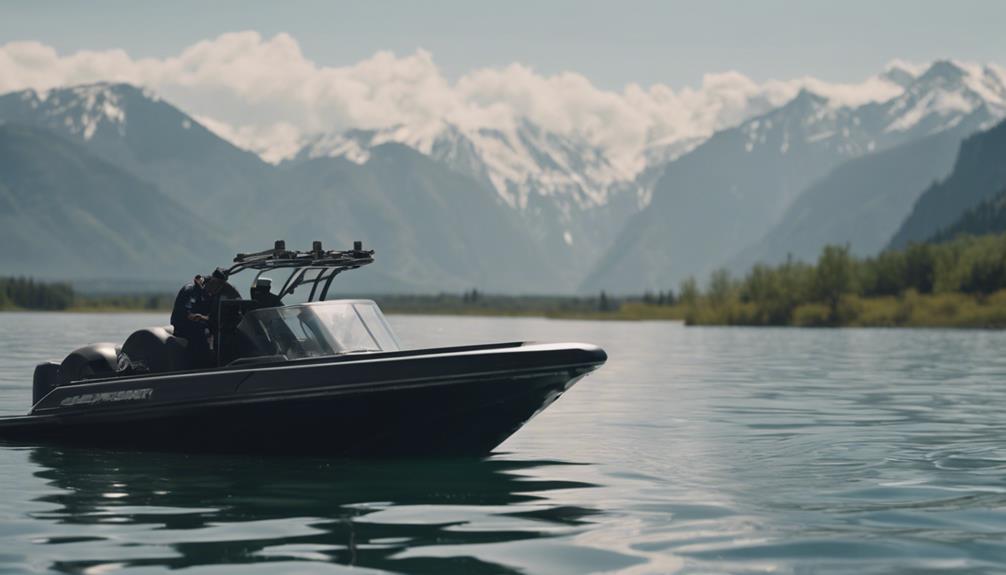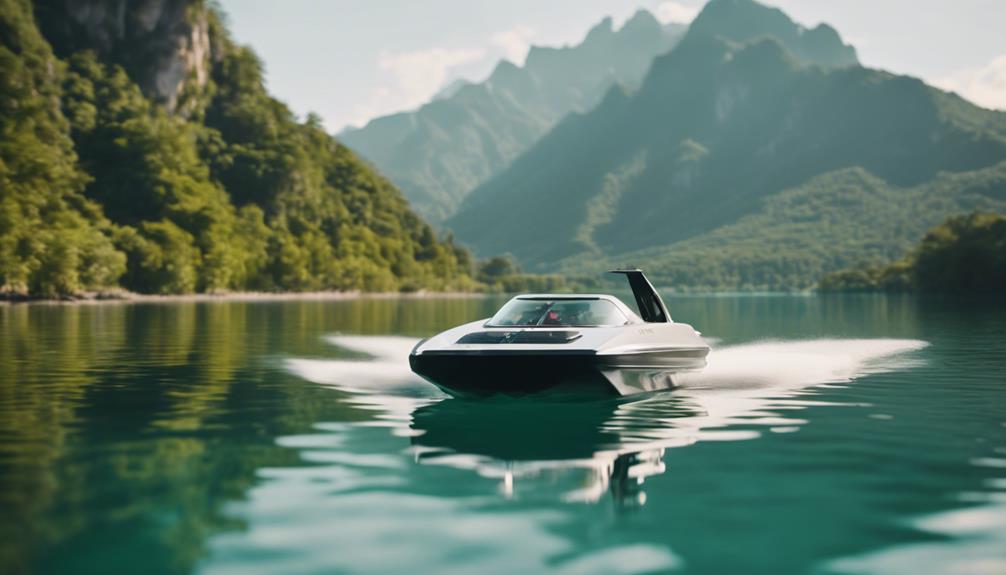If your jet boat won't plane, check a few key areas first. Start by evaluating weight distribution; moving passengers and gear forward can improve lift. Adjust your trim settings gradually to find the right angle for speed. Inspect the propeller for any damage and verify it's the correct size to avoid power loss. Don't forget to monitor your engine RPM; aiming for around 5,000 RPM during acceleration is essential for effective planing. Keep your hull clean and inspect the fuel system too. There's more you can do for peak performance, so keep exploring these tips.
Key Takeaways
- Verify proper weight distribution; shifting weight forward can help lower the bow and improve lift for planing.
- Adjust the trim angle of the outboard motor; start with trim down for lift and gradually trim up as speed increases.
- Inspect the propeller for damage; ensure it is the correct size and pitch to avoid power loss and enhance planing capability.
- Monitor engine RPM during acceleration; aim for around 5,000 RPM to effectively achieve and maintain plane.
Jet Boat Basics
Jet boats rely on a jet propulsion system, which includes vital components like the jet pump, impeller, and steering nozzle to move efficiently on the water. The jet pump is important for generating thrust, pulling water through the inlet and expelling it through the nozzle, allowing your boat to glide smoothly.
When everything's functioning well, your jet boat can achieve planing, where it rides on top of the water's surface, greatly reducing drag and increasing speed.
To achieve ideal planing, you need to verify that your jet pump and impeller are in good condition. If you're struggling to get your boat on plane, it might indicate issues like ride plate gasket problems or malfunctions in the jet pump itself. Regular maintenance checks are vital to avoid cavitation, which can hinder thrust efficiency and affect overall performance.
Understanding these basics will help you troubleshoot and maintain your jet boat effectively. With the right care and attention, you can maximize your jet boat's capabilities, guaranteeing a smooth ride and an enjoyable experience on the water.
Weight Distribution Issues
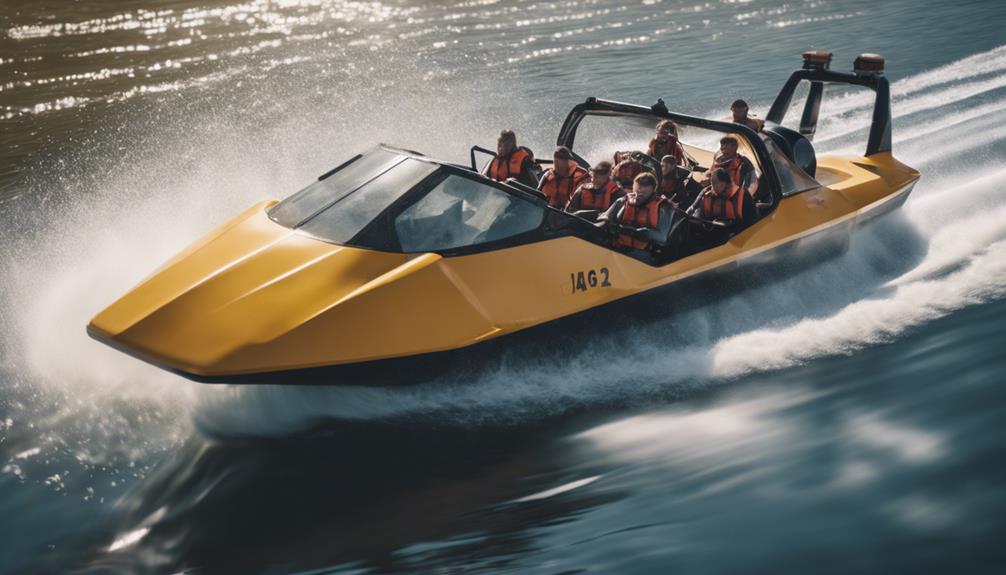
When you're out on the water, proper weight placement can make all the difference in your jet boat's performance.
You might need to adjust the location of your batteries and heavy gear to the front, ensuring a balanced ride.
A few simple tweaks can drastically improve your boat's stability and ability to plane efficiently.
Proper Weight Placement
Proper weight distribution is essential for maximizing your jet boat's performance, as even minor imbalances can hinder your ability to achieve and maintain plane.
If you're struggling to get your jet boat up to speed, consider these key tips for proper weight placement:
- Shift weight forward: If you have too much weight in the back, moving gear or passengers towards the front can help lower the bow, enhancing lift.
- Adjust passenger placement: Distributing passengers evenly across the boat can prevent tipping and help maintain stability.
- Trim the motor: Adjusting the trim can also play a role in how weight affects performance. Confirm it's set correctly for maximum lift.
- Test different configurations: Use temporary weights to experiment with various placements until you find the ideal balance for achieving plane.
Front Weight Addition
Adding weight to the front of your jet boat can greatly enhance its performance by improving balance and helping it achieve plane more easily. If your boat struggles to reach a plane, it might be due to too much weight at the rear. To correct this, consider relocating heavy items like batteries to the front. Alternatively, you can use temporary solutions, such as filled buckets, to shift weight forward.
It's important to remember that jet boats are sensitive to weight distribution. Even minor adjustments can lead to significant changes in performance. Regularly evaluating your boat's weight distribution is essential; improper positioning can cause sluggish acceleration and hinder your ability to reach ideal speeds.
Battery Location Adjustment
Relocating your battery towards the front of the jet boat can greatly enhance its balance and overall performance. Proper weight distribution is crucial for ideal planing, and shifting the battery can help lift the bow, reducing issues like porpoising.
Here are some tips to keep in mind when adjusting your battery location:
- Test with Temporary Weights: Use buckets filled with water to simulate the battery's weight before making permanent changes. This helps you understand how weight distribution affects performance.
- Secure the Battery: Always secure the battery in a full box or with ratchet straps. This prevents any shifting during operation, which could further disrupt your weight distribution.
- Monitor Performance: After relocating the battery, observe how your boat planes. This feedback can guide you in finding the best configuration for your specific load conditions.
- Adjust as Needed: If you're still experiencing issues, think about additional changes in weight distribution. The key is to find the ideal placement for your setup.
Trim Adjustment Techniques
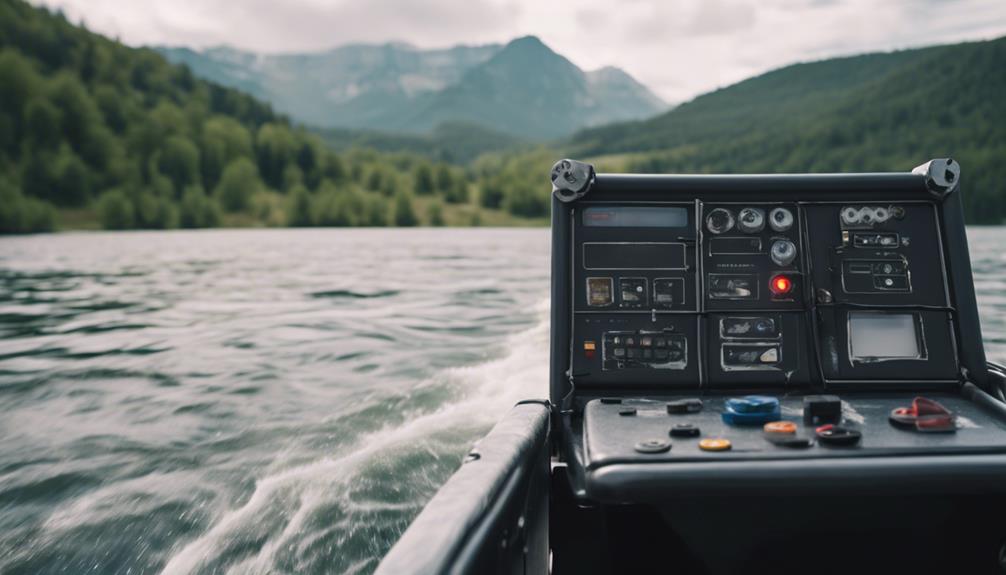
Getting your trim right is key to achieving ideal performance on the water.
You'll want to start by trimming down for lift and gradually trim up as you pick up speed.
Importance of Proper Trim
Proper trim is essential for jet boats, as it directly impacts your ability to reach plane efficiently and maintain ideal speed on the water. If your boat won't plane, improper trim could be the culprit.
It's vital to adjust the trim correctly to achieve the right angle of the motor relative to the water, which affects lift and speed.
Here are some trim adjustment techniques to keep in mind:
- Start Trim Down: Begin with the trim down to help lift the bow and reduce drag as you accelerate.
- Gradual Trim Up: Once you gain speed and the boat starts to plane, gradually trim up to optimize performance and stability.
- Monitor Weight Distribution: Check how weight is distributed in your boat. Uneven weight can affect trim and performance.
- Adapt to Conditions: Regularly adjust your trim settings based on water conditions, as different environments can require changes for efficiency.
Adjusting Trim Tabs
Adjusting trim tabs can greatly enhance your jet boat's performance by ensuring a more level attitude on the water. Properly set trim tabs can markedly reduce porpoising and improve planing performance, allowing for a smoother ride and better control.
To adjust the trim effectively, use a hammer and a block of wood to bend the tabs slightly. Make sure both tabs are adjusted evenly to maintain balanced performance. Even minor adjustments can lead to noticeable changes in stability and speed, so monitor your boat closely during operation.
It's wise to test the effects of your adjustments at various speeds. This will help you discover the best configuration for maintaining plane and handling across different water conditions.
Keep in mind that load distribution can also affect your jet boat's performance, so regularly inspect and adjust the trim tabs as needed.
Propeller and Impeller Inspection
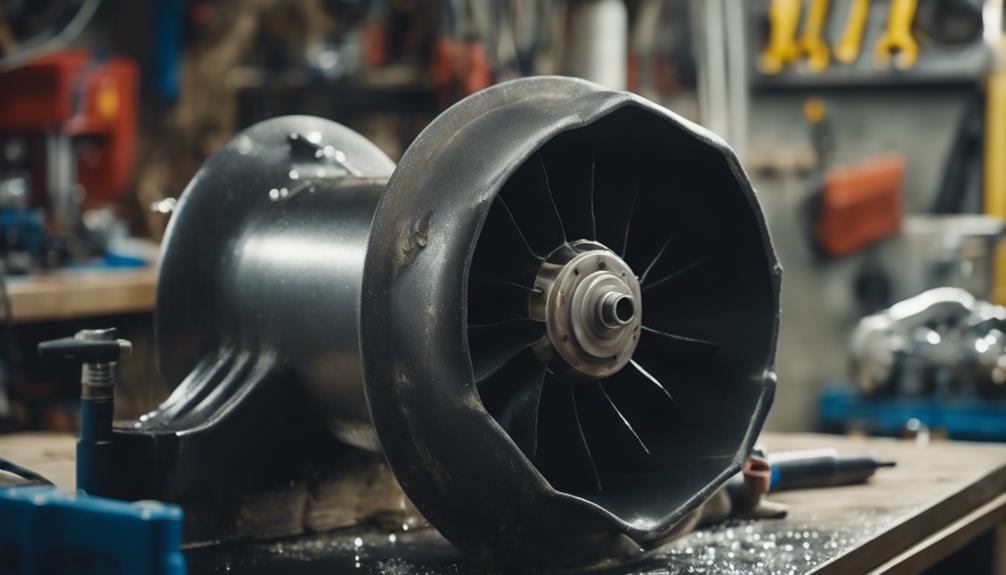
Inspecting the propeller and impeller is essential for maintaining your jet boat's performance and guaranteeing it can effectively plane on the water. If either component is compromised, your boat may struggle to achieve the necessary speed and stability. Here's what you should check:
- Propeller Damage: Look for any bent blades or dings on the propeller. Even minor damage can greatly impact your jet boat's ability to plane efficiently.
- Propeller Specifications: Verify the size and pitch of the propeller are appropriate for your boat. For a typical 150 hp outboard, common specs are 13-14D x 22P, 3 blade SST.
- Impeller Condition: Inspect the impeller for wear and damage. A compromised impeller reduces thrust and acceleration, making it difficult to achieve plane.
- Gap Monitoring: Check the gap between the impeller and the wear ring. Excessive gaps can lead to cavitation, which decreases propulsion efficiency and affects your boat's performance.
Engine and Fuel System Checks
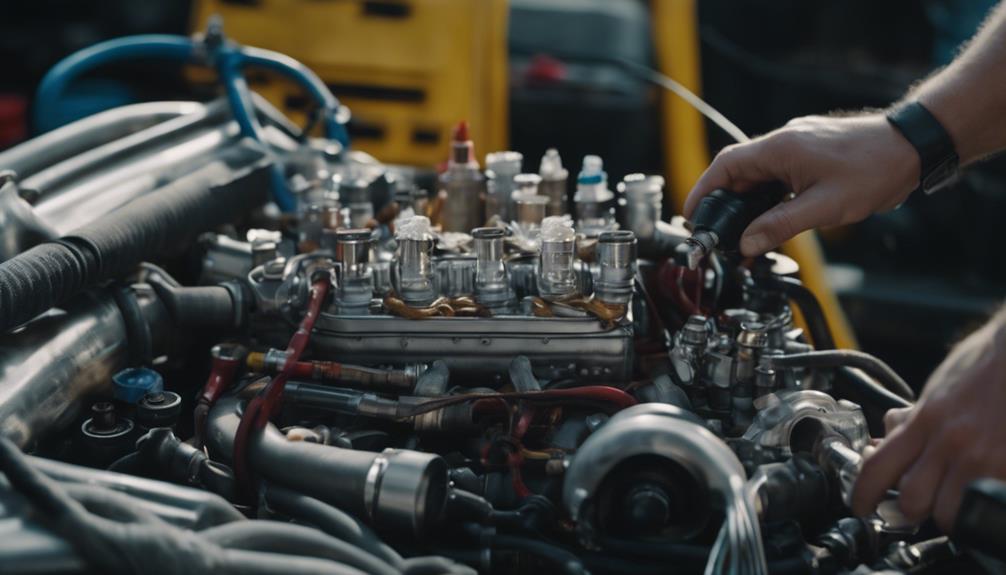
Maintaining your jet boat's engine and fuel system is just as important as checking the propeller and impeller to assure peak performance on the water.
Start by inspecting the fuel pump; a malfunctioning pump can lead to fuel starvation, making it difficult for the engine to reach the RPMs needed for planing. If you notice any irregularities, consider testing or replacing the pump.
Next, check the fuel filter. A clogged fuel filter can restrict fuel flow, resulting in inadequate engine power and preventing effective planing. Regular inspection and replacement of the filter are essential to guarantee smooth fuel delivery.
Additionally, look at the integrity of the fuel lines and connections. Contaminants in the fuel system can wreak havoc on engine performance, so always use fresh fuel and keep everything clean.
Don't forget about your spark plugs; improper conditions can severely impact ignition. Regularly checking and replacing them can help maintain reliable power delivery.
Common Troubleshooting Steps
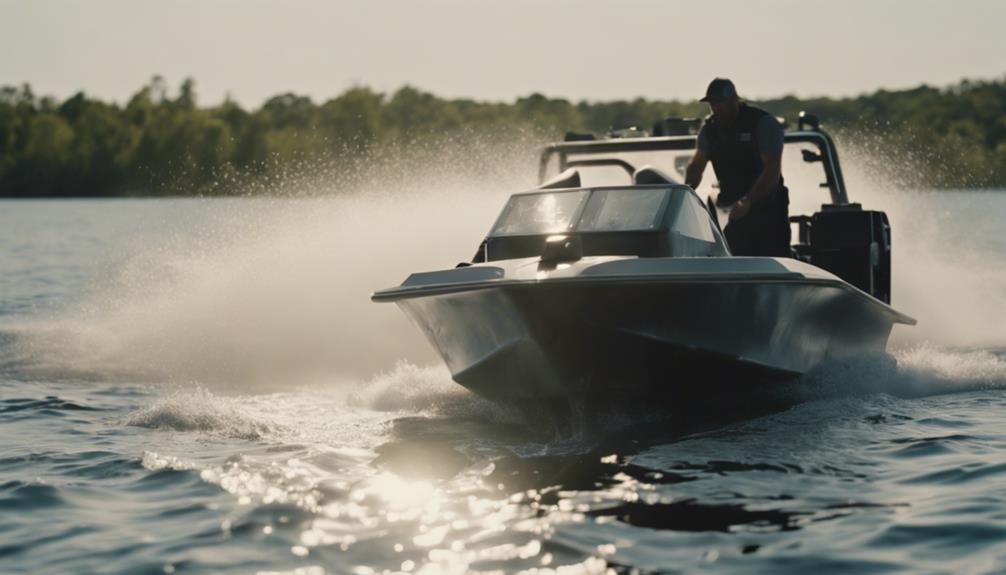
Start by affirming proper weight distribution within your jet boat, as uneven weight can considerably hinder your ability to plane effectively. If your boat's weight isn't balanced, consider relocating batteries or adding weight to the front to improve performance.
Next, follow these common troubleshooting steps:
- Check Trim Settings: Adjust the trim of your outboard motor. Start with the trim down and gradually trim up as your boat begins to plane to find the ideal angle.
- Inspect the Propeller: Look for any signs of damage or verify that the propeller size and pitch are appropriate. A spun hub or incorrect specifications can lead to power loss.
- Monitor Engine RPM: During acceleration, check your engine RPM. You should aim for around 5,000 RPM for planing. If you're not hitting this mark, there might be engine issues or fuel blockages.
- Clean the Hull and Jet Pump: Regularly maintain and clean these components. Fouling increases drag, which can drastically reduce your boat's speed and ability to plane.
Maintenance Best Practices
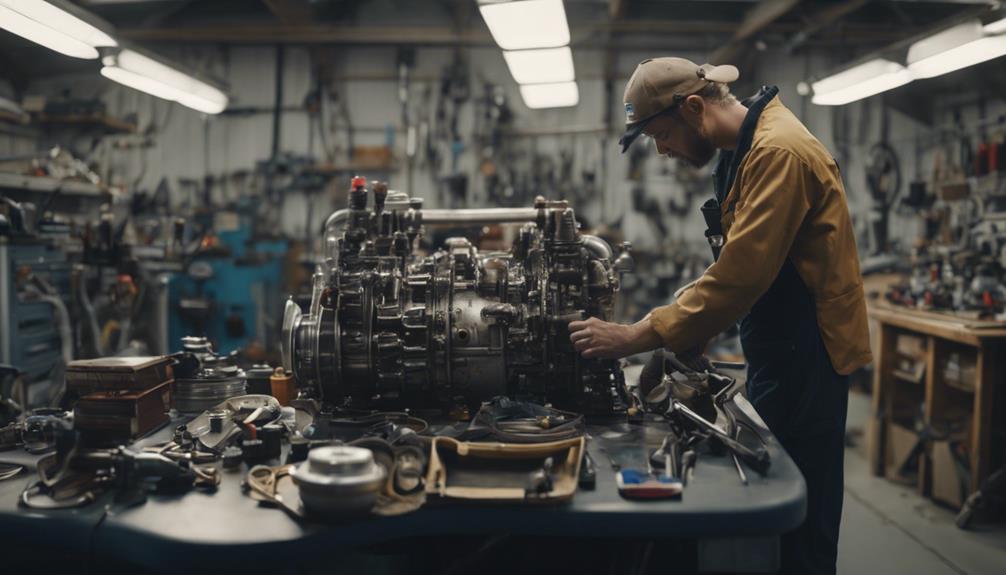
How often do you check the fuel system components in your jet boat to guarantee ideal performance and avoid costly repairs? Regular inspections and cleanings of filters and injectors are vital for confirming fresh fuel flow, which prevents performance issues.
You should also pay close attention to the jet pump and impeller; any signs of damage or wear can greatly impact your boat's propulsion and ability to plane.
Proper weight distribution is another key aspect of maintenance. Regularly assess and adjust the placement of passengers and gear to optimize your boat's ability to plane effectively.
Additionally, routine engine maintenance is essential. Check spark plugs, ignition systems, and conduct engine compression tests to catch any underlying performance issues early on.
Lastly, don't forget to keep the hull clean and free of fouling. Barnacles and debris can increase drag, considerably hindering your boat's planing capability.
Community Resources and Support
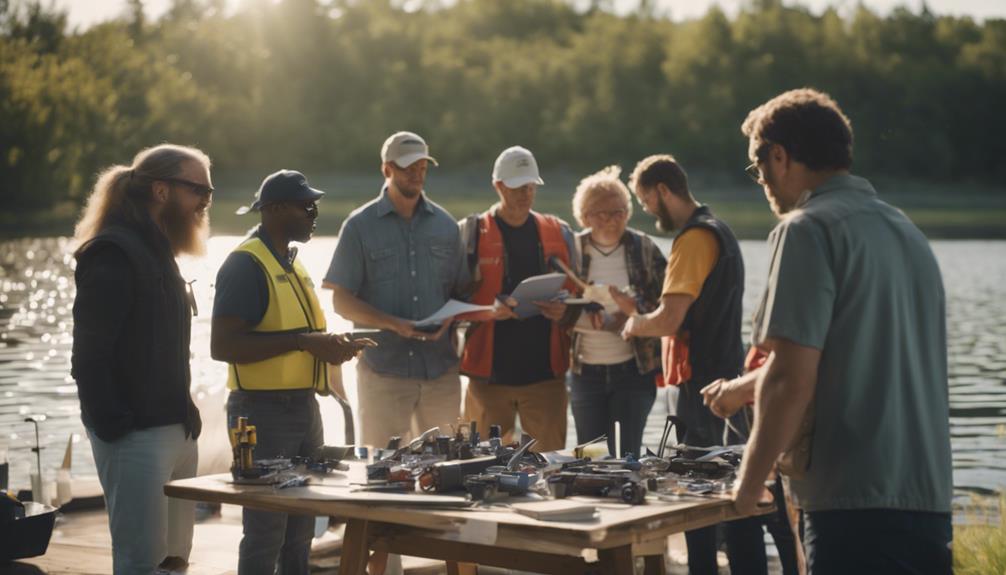
Finding support and resources within the jet boat community can greatly enhance your troubleshooting process and help you tackle performance issues more effectively. Engaging in community discussions allows you to connect with others who share similar challenges and successes.
Here are four ways to leverage community resources for resolving performance problems:
- Join Online Forums: Participate in platforms where jet boat owners exchange troubleshooting tips and personal experiences. These discussions can provide valuable insights into common issues.
- Share Your Experiences: Post detailed accounts of your performance challenges. Sharing what you've tried can help others learn from your successes and setbacks.
- Ask for Recommendations: Seek advice on maintenance practices, like regular inspections of the jet pump and impeller, which can prevent further performance problems.
- Consult with Experts: While community advice is invaluable, don't hesitate to reach out to certified marine technicians for expert diagnoses on persistent issues.
Expert Recommendations and Advice
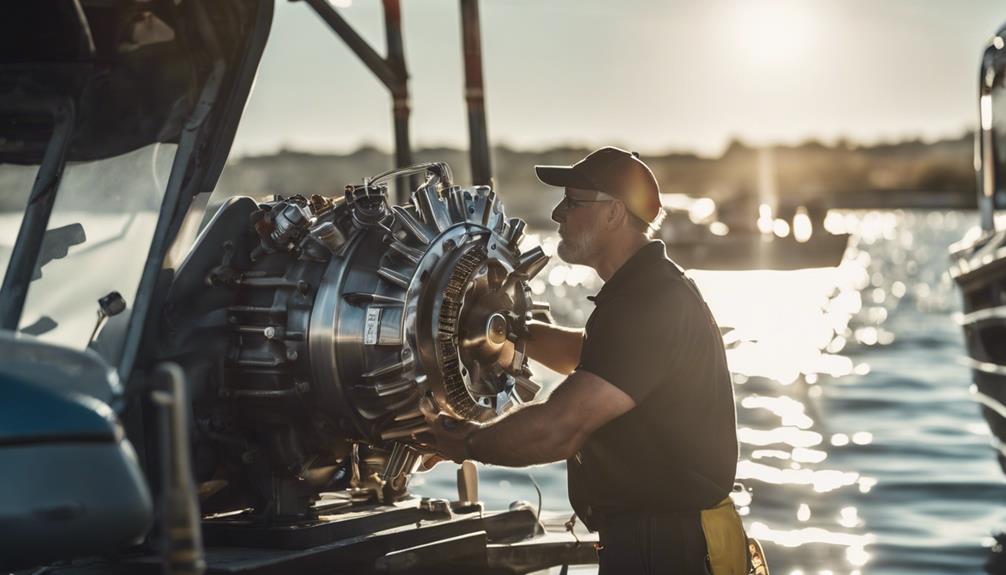
Getting expert recommendations can make a significant difference in resolving jet boat performance issues.
First, pay attention to weight distribution. If your boat's weight is uneven, it can struggle to achieve planing. Make certain to move any excessive weight forward, which can help balance the boat and improve its ability to plane.
Next, regularly check the trim angle of your outboard motor. An incorrect trim can limit lift and speed during planing, so adjust it as needed. Additionally, inspect your propeller for any damage or improper sizing. A spun hub or issues with the cavitation plate height can seriously impact your boat's planing capability.
Don't overlook the importance of RPM during acceleration. Aim for at least 5,000 RPM to guarantee your jet boat can achieve proper planing.
Finally, keep your fuel system clean. Regularly check and replace filters to avoid fuel starvation, which can negatively affect engine performance and your boat's ability to plane.
Frequently Asked Questions
What Would Cause a Boat Not to Plane?
A boat might not plane due to improper weight distribution, incorrect trim settings, a damaged propeller, fuel system issues, or engine performance problems. Regular maintenance and adjustments can help you achieve better planing.
Why Won't My Boat Get up on the Plane?
If your boat won't get up on the plane, check weight distribution, adjust the trim angle, inspect the propeller, guarantee a clean fuel system, and monitor engine RPM for peak performance.
How Do I Get My Boat to Plane Out?
To get your boat to plane out, shift heavy items forward, adjust the trim gradually, check the propeller size, inspect the jet pump, and make certain your engine reaches at least 5,000 RPM.
How Do You Get a Jet Boat on a Plane?
To get your jet boat on a plane, adjust weight distribution forward, monitor RPMs around 5,000, and trim the motor gradually. Inspect the jet pump for obstructions, and consider adding trim tabs for better lift.
How Can I Ensure My Jet Boat Will Plane Properly After Purchasing?
After purchasing a jet boat, ensuring it planes properly is crucial for a smooth ride. Check the boat’s weight distribution and adjust as needed. Make sure the intake grate is clear of debris and verify that the impeller is in good condition. If you’re unsure, seek guidance from experts at a reputable store where to buy jet boat accessories.
Conclusion
To summarize, getting your jet boat to plane can be frustrating, but with the right troubleshooting tips, you can get back on the water in no time.
Did you know that nearly 70% of jet boat owners experience planing issues at some point?
By carefully checking weight distribution, trim settings, and engine performance, you'll not only enhance your boating experience but also guarantee safer outings.
Don't hesitate to tap into community resources for additional support and advice!

